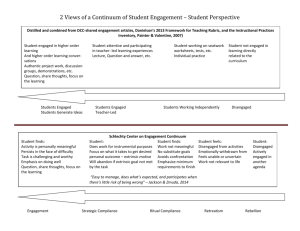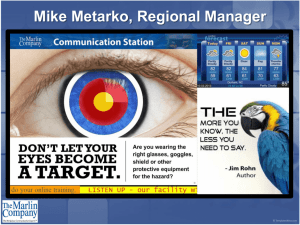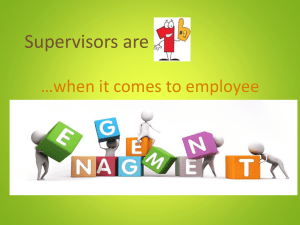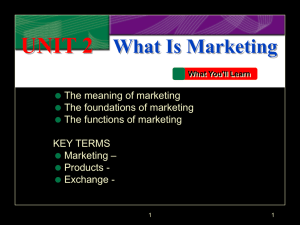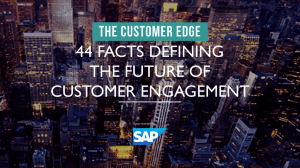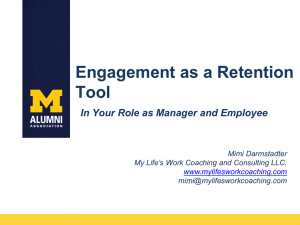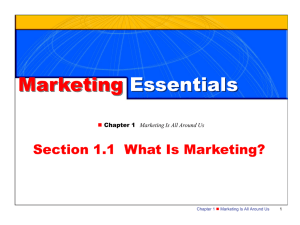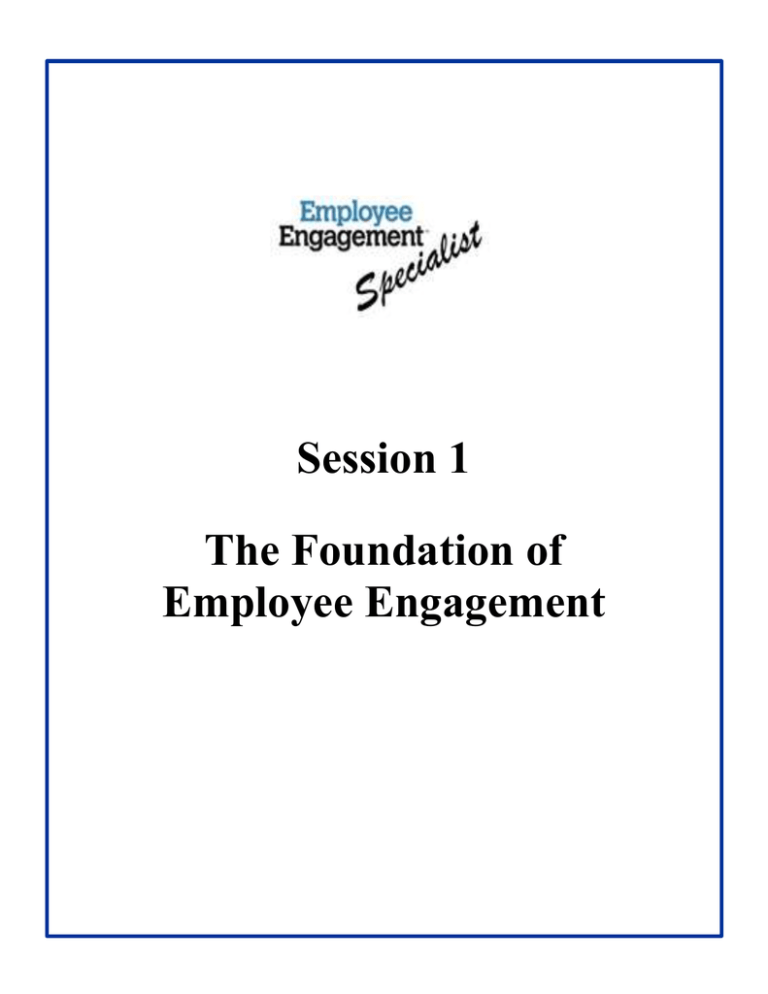
Session 1
The Foundation of
Employee Engagement
This page intentionally left blank
Working Definition of Engagement
Company
Performance
Employee
Engagement
Employee
Potential
Employee Engagement is unlocking your employees’ potential to drive high performance. It’s a mutual
commitment resulting in the capture of discretionary effort.
Discretionary Effort
What does ‘discretionary effort’ look like in your organization?
Highly engaged employees are:
480% more committed to
helping their company succeed
370% more likely to recommend
their company as an employer
250% more likely to recommend
improvements
What are your employees doing to demonstrate discretionary effort?
© The Employee Engagement Group
All Rights Reserved
1-1
Session 1
Foundations
Employee Engagement Today
2015 Disengagement
67.5%
Disengaged
51%
Engaged
32.5%
Actively
Disengaged
16.5%
2.5% Increase
since 2013
January 2015 Gallup Report of 80,000 Employee Interviews
© The Employee Engagement Group
All Rights Reserved
1-2
Session 1
Foundations
Employee Engagement at your Organization
According to the most recent Gallup study of studies of 192 organizations globally the breakdown of
engaged employees is:
Engaged – 32.5% (up from 30%)
Not engaged – 51% (down from 52%)
Actively disengaged – 16.5% (down from 18%)
Using the form below:
In your best estimate, what percentage of your employees fall into each of the Gallup
categories?
What are you currently doing to attempt to bring the actively disengaged and not engaged
categories into the engaged column?
What are you currently doing to keep the engaged employees engaged?
Write ideas from other participants – how can you improve each area in ways you hadn’t
thought of?
Gallup Study
Engaged
Not Engaged
Actively Disengaged
32.5%
51%
16.5%
What % would
you think each
is at your
company?
Current actions
– what are
some examples
of actions being
taken to
address each
category of
employee?
Ideas from
discussion –
what are others
doing that you
can implement
in your
organization?
© The Employee Engagement Group
All Rights Reserved
1-3
Session 1
Foundations
Business Case for Engagement
____________________________________________________
“Stuff” vs. Engagement
Engagement is not about:
Things
Having the best of every amenity
Avoiding making tough decisions
Pleasing all the people all of the time
A ‘catch-phrase’ for all HR programs
Engagement is about:
People
Relationships
Alignment
Shared responsibility for creating business
success and a great work environment
Continuous communication
Opportunities for performers
Staff development
Employee engagement is NOT a short-term program,
employee engagement is a culture!
© The Employee Engagement Group
All Rights Reserved
1-4
Session 1
Foundations
Exercise: Discuss your assigned article and come up with:
Key aspects of what you learned from reading the article and how you can apply it to your
organization
Be prepared to report back 3 - 5 ‘ah-ha’ or ‘I think I’ve heard that…’ information with examples
of potential application
Use the chart below to note the report back information from each article
It’s Not You, It’s me – The Bootstrapper’s Guide to
Employee Engagement (Kinexis)
Global Human Capital Trends 2015 (Deloitte)
Culture and Engagement (pages 35 – 39)
Global Human Capital Trends 2015 (Deloitte)
Performance Management (pages 51 - 56)
Why Engagement Happens in
Employees’ Hearts (Fast Company)
© The Employee Engagement Group
All Rights Reserved
1-5
Session 1
Foundations
Key Facts about Employee Engagement
Statistic
Job Gains and Losses are approaching 2000 levels
Source
National Job Gains and Losses
Andrew Van Dam, Renee
Lightner
Wall Street Journal,
February 2015
Job Openings and Hiring is on the rise; number of
employees quitting is decreasing
Job Openings and Labor
Turnover Survey
Bureau of Labor Statistics
January 2015
Human Capital Effectiveness
Report
PwC Saratoga
2012 - 2013
© The Employee Engagement Group
All Rights Reserved
1-6
Session 1
Foundations
Statistic
Employee Engagement Drivers:
Satisfaction with immediate supervisor
Trust in senior leadership
Pride in the organization
Source
What Drives Employee
Engagement Survey of 1,500
global employees
Dale Carnegie, 2012
30% of your employees will be looking for a new job in 2015 CareerBuilder.com, 2015
86% of employees will be looking for a new job in 2015
Right Management Poll, 2015
The #1 priority of 3,300 global leaders in 106 countries is
employee engagement.
Global Human Capital Trends
Deloitte, 2015
Less than 40% of companies focus on employee
engagement
2013 Survey: Creating a High
Performance Work
Environment
SilkRoad Technologies
Engagement by the size of the organization
Employee Engagement
Insights for US Business
Leaders (2013)
Gallup
Top ways to Foster Engagement:
1. Trust in Management
2. Career development
3. Stimulating work environment
4. Recognition and rewards
5. Flexible work options (e.g., work from home)
6. Learning opportunities
7. Career advancement
8. Salary
9. Good benefits (medical, dental)
10. Mentoring
11. Diversified comp options (e.g., pay)
12. Good pension and retirement plans
© The Employee Engagement Group
All Rights Reserved
1-7
2013 Survey: Creating a High
Performance Work
Environment
SilkRoad Technologies
Session 1
Foundations
Statistic
Best way to build trust in management
1. Show concern about the well-being of people
2. Demonstrate a high level of integrity
3. Demonstrate competence
Source
2013 Employee Engagement
Index Scores, Workforce
Trends Report (33,000
employees in 28 countries)
Kenexa
Disengaged managers are 3 times more likely to have
disengaged employees
Driving Performance and
Retention through Employee
Engagement (2012)
Corporate Leadership Council
Bad managers are creating active disengagement costing
the U.S. an estimated $450 billion to $550 billion annually.
2013 State of the American
Workplace Report (based on
25 million survey respondents)
Gallup
35% of U.S. Workers said they’d willingly forgo a substantial
pay raise in exchange for seeing their direct supervisor
fired.
2012 Employee Poll
Disengaged employees cost the U.S. Economy $370 billion
annually.
Employee Engagement: Every
Leader’s Imperative (May,
2013)
Parade Magazine
Forbes.com
Highly engaged employees are 87% less likely to leave their
companies than their disengaged counterparts.
Employees with lower engagement are 4 times more likely
to leave their jobs than those who are highly engaged
Only 41% of employees felt that they know what their
company stands for and what makes its brand different
from its competitors.
Driving Performance and
Retention through Employee
Engagement (2012)
Corporate Leadership Council
2013 State of the American
Workplace Report (based on
25 million survey respondents)
Gallup
© The Employee Engagement Group
All Rights Reserved
1-8
Session 1
Foundations
Statistic
Engagement changes by level in the organization:
Level
Executive (VP and up)
Director
Team Ldr, PM, Tech
Manager/Supervisor
Consultant
Specialist/Professional
Admin/Clerical
% engaged
59
41
39
39
33
29
27
% disengaged
9
12
14
12
16
20
21
Organizations that are growing have 43% engaged
employees vs. 13% engagement in organizations that are
letting employees go
Source
2013 Global Employee
Engagement Research Update
Blessing White
2013 State of the American
Workplace Report (based on
25 million survey respondents)
Gallup
Organizations driven by purpose and values outperformed
comparison companies 6X.
Research by Jim Collins and
Jerry Porras
Engagement levels are twice as high (54% vs. 25%) among
those who say they are proud of contributions their
organization has made to the community
Global Statistics and Corporate
Social Responsibility Survey
Dale Carnegie, 2012
Engaged businesses have:
28% higher revenue per employee
87% greater ability to hire the best people
156% greater ability to develop great leaders
92% greater ability to respond to economic issues
114% greater ability to plan for the future
2013 Market Analysis, Trends
and Provider Profiles
Bersin Talent
Management Systems
28% less downsizing
40% lower turnover of high performing employees
17% lower overall voluntary turnover
© The Employee Engagement Group
All Rights Reserved
1-9
Session 1
Foundations
What Does an Engaged Employee Look Like?
Where would you put yourself on the circles below? Where would your staff put themselves?
I’m not doing what I
really like to do; I’m not
sure I’m even good at
doing what I’m asked to
do
I like some of what I’m
doing, but doing a lot of
things I don’t
particularly like doing;
I’m not really leveraging
my skills
© The Employee Engagement Group
All Rights Reserved
I like most aspects of
my job; I believe I’m
really skilled in most of
what I’m being asked to
do
1 - 10
I love what I do. My
skills are a perfect
match for my position
Session 1
Foundations
Engagement and Purpose Ideas
What are the ‘purpose-driven aspects of your organization?
Do you support specific organizations or causes?
Who selected those causes? The employees? Leadership?
How are causes selected?
Cause or organization supported
Who suggested the cause and
who made the decision to
support this cause?
What was the process for selecting
this cause over the other suggested
causes?
What ideas have you gotten from other participants?
© The Employee Engagement Group
All Rights Reserved
1 - 11
Session 1
Foundations
Who are your Engagement Change Agents?
Using the pre-work you completed, identify those people in your organization that will support
developing engagement (these are your Engagement Change Agents). These people are normally the
decision makers for corporate change and improvement, i.e., CEO, CFO, EVP, VP, Director, and
Department/Division Leaders.
Write the name or position of each Engagement Change Agent in the left-hand column then rate each
one, low to high, on their:
Understanding – how much do you think they understand the concept of engagement and what
is required; how much education on engagement will they need?
Influence – what is their influence on the organization? What is their level of ability to help you
implement a culture of engagement?
Low
Name
Example:
Director of Finance
Understanding:
Influence:
|
|
High
|
|
|
|
|
|
|
|
|
|
|
|
|
|
|
|
|
|
_____________________________________________________________________________________________________________
Low
Name
Understanding:
Influence:
|
|
|
|
|
|
|
|
|
|
|
|
|
|
|
|
Low
Name
Understanding:
Influence:
|
|
Understanding:
Influence:
|
|
|
|
|
|
|
|
|
|
|
|
|
|
|
|
|
|
Understanding:
Influence:
|
|
|
|
|
|
|
|
|
|
|
|
|
|
|
|
|
|
Understanding:
Influence:
|
|
|
|
|
|
|
|
|
|
|
|
|
|
|
|
|
|
Understanding:
Influence:
1 - 12
|
|
|
|
High
|
|
|
|
|
|
|
|
|
|
|
|
|
|
|
|
Low
Name
|
|
High
Low
Name
|
|
High
Low
Name
|
|
High
Low
Name
© The Employee Engagement Group
All Rights Reserved
|
|
High
|
|
High
|
|
|
|
|
|
|
|
|
|
|
|
|
|
Session 1
Foundations
|
|
|
|
Who are your Engagement Adversaries?
Using the pre-work you completed, identify those people in your organization that may resist
developing engagement (these are your Engagement Adversaries). As with the Engagement Change
Agents, these people are also the decision makers for corporate change and improvement, i.e., CEO,
CFO, EVP, VP, Director, and Department/Division Leaders.
Write the name or position of each Engagement Adversary in the left-hand column then rate each one,
low to high, on their:
Understanding – how much do you think they understand the concept of engagement and what
is required; how much education on engagement will they need?
Influence – what is their influence on the organization? What is their level of ability to hinder
your efforts to implement a culture of engagement?
Low
Name
Understanding:
Influence:
|
|
|
|
|
|
|
|
|
|
|
|
|
|
|
|
|
|
|
|
|
|
|
|
|
|
|
|
|
|
|
|
Low
Name
Understanding:
Influence:
|
|
Understanding:
Influence:
|
|
Understanding:
Influence:
|
|
|
|
|
|
|
|
|
|
|
|
|
|
|
|
|
|
Understanding:
Influence:
|
|
|
|
|
|
|
|
|
|
|
|
|
|
|
|
|
|
Understanding:
Influence:
1 - 13
|
|
|
|
High
|
|
|
|
|
|
|
|
|
|
|
|
|
|
|
|
Low
Name
|
|
High
Low
Name
|
|
High
Low
Name
|
|
High
Low
Name
© The Employee Engagement Group
All Rights Reserved
|
|
High
|
|
High
|
|
|
|
|
|
|
|
|
|
|
|
|
|
Session 1
Foundations
|
|
|
|
Engagement in your Organization Evaluation
Thinking about your organization, rate each of the following key engagement components on a scale of
1 – 10:
1 being the lowest rating
10 being the highest rating
Key Engagement Component
1. Our Leadership supports making changes necessary to
have an engaged culture
Rate your organization 1 = lowest, 10 = highest
1
2
3
4
5
6
7
8
9
10
1
2
3
4
5
6
7
8
9
10
1
2
3
4
5
6
7
8
9
10
1
2
3
4
5
6
7
8
9
10
1
2
3
4
5
6
7
8
9
10
1
2
3
4
5
6
7
8
9
10
1
2
3
4
5
6
7
8
9
10
1
2
3
4
5
6
7
8
9
10
1
2
3
4
5
6
7
8
9
10
1
2
3
4
5
6
7
8
9
10
1
2
3
4
5
6
7
8
9
10
1
2
3
4
5
6
7
8
9
10
1
2
3
4
5
6
7
8
9
10
1
2
3
4
5
6
7
8
9
10
1
2
3
4
5
6
7
8
9
10
1
2
3
4
5
6
7
8
9
10
1
2
3
4
5
6
7
8
9
10
1.1
2. We conduct regular surveys to identify how our employees
are feeling and thinking
2.1
3. Our organization has a purpose for being in business over
and above making money
3.1
4. We use interviewing techniques to identify behaviors and
traits of potential employees, not just experience and skills
4.1
5. We listen to our employees’ feedback and take action to
implement good ideas
5.1
6. We know why employees want to work for us
6.1
7. Our employees speak highly of our organization; they seem
to be proud to be a part of this organization
7.1
8. Our customers / clients speak highly of our organization
8.1
9. We have a process for embracing and managing change
within the organization
9.1
10. Our first-line leaders are fully engaged in the business
10.1
11. Our first-line leaders represent leadership in a positive
manner to employees
11.1
12. We have a structured process for communicating
important information to all employees
12.1
13. We proactively use social media tools to communicate with
our employees, e.g., Twitter, Yammer, and Facebook
13.1
14. We teach managers how to work with people from
different generations, especially Generation Y
14.1
15. We teach managers how to interview candidates for jobs
15.1
16. We have a culture that encourages innovation
16.1
17. We have an established structure for collecting employee
ideas for making improvements to what we do
17.1
© The Employee Engagement Group
All Rights Reserved
1 - 14
Session 1
Foundations
Engagement in your Organization Evaluation (continued)
Key Engagement Component
18. Our managers create a culture that motivates employees
to do their best
Rate your organization 1 = lowest, 10 = highest
1
2
3
4
5
6
7
8
9
10
1
2
3
4
5
6
7
8
9
10
1
2
3
4
5
6
7
8
9
10
1
2
3
4
5
6
7
8
9
10
1
2
3
4
5
6
7
8
9
10
1
2
3
4
5
6
7
8
9
10
1
2
3
4
5
6
7
8
9
10
1
2
3
4
5
6
7
8
9
10
1
2
3
4
5
6
7
8
9
10
1
2
3
4
5
6
7
8
9
10
1
2
3
4
5
6
7
8
9
10
1
2
3
4
5
6
7
8
9
10
1
2
3
4
5
6
7
8
9
10
18.1
19. We have an effective process to measure employee
performance on an ongoing basis
19.1
20. Our employees go the extra mile without being asked
20.1
21. Health, welfare, and safety is a priority in our environment
and culture
21.1
22. Employee retention is a key business measurement
22.1
23. We have a structured reward and recognition process that
is practiced by all managers
23.1
24. Our employees are compensated fairly for what they do
24.1
25. Our employees (managers and staff) are key players in the
selection of new staff
25.1
26. Recognizing the diverse nature of our employees is
important to the organization
26.1
27. We have an effective system for measuring employee
performance
27.1
28. Customers/clients feedback is collected and evaluated on
an ongoing basis
28.1
29. Employee Engagement is a key topic during high level
corporate review meetings
29.1
30. Voluntary turnover has minimum impact on our business
Note: the smaller the impact of turnover, the higher you should rate
30.1
Based on your answers, write or highlight the 3 – 5 areas that you think, if improved in your
organization, would cause engagement levels would increase.
© The Employee Engagement Group
All Rights Reserved
1 - 15
Session 1
Foundations
© The Employee Engagement Group
All Rights Reserved
1 - 16
Session 1
Foundations
Engagement
Action Plan
and
Session 2 Pre-work
© The Employee Engagement Group
All Rights Reserved
Session 1
Foundations
This page intentionally left blank
© The Employee Engagement Group
All Rights Reserved
Session 1
Foundations
Engagement Action Plan
1. What are the key business drivers of engagement you want to share with your senior leadership to help them
understand the benefits of implementing an engagement culture?
2. From our discussion of Purpose, what are 3 ideas that might help your organization improve its focus on purpose?
Review your notes on what others have done and be prepared to ask individuals for more clarification.
3. Based on your Engagement Organization Evaluation, what are 3 – 5 areas that, if improved, would increase your
engagement levels? In the right-hand column, write actions you could take to begin the improvement process.
Improvement Area
Actions to Make Improvements
© The Employee Engagement Group All Rights Reserved
1
Use additional pages if needed
Please finish all sections and be prepared to discuss during Session 2
Session 1 Action Plan
Engagement Action Plan (continued)
4. Using the information from Session 1 and what you noted on page 1 of this document, meet with at 2-3 senior
leaders and discuss engagement. Take notes about your discussion below.
What specifically did you talk about?
What went well?
What are your challenges?
5. Think about the key EA you listed in your workbook. Create a strategy for each that will help you to influence them
to support the engagement culture.
EA
Strategy
© The Employee Engagement Group All Rights Reserved
2
Use additional pages if needed
Please finish all sections and be prepared to discuss during Session 2
Session 1 Action Plan
Session 2 Pre-work
1. Identify tools you have used in your organization to gather information for determining engagement levels and
the pros and cons of using each
Tool for Measuring Engagement
Pros
Cons
Engagement Survey
Pulse Survey
Town Hall Meeting
Team Meetings
Committees
1 on 1 Employee Meetings
Suggestion Boxes
Other
2. Read the articles posted on your Specialist web site.
© The Employee Engagement Group All Rights Reserved
1
Session 2 Pre-work
Use additional pages if needed
Please complete as much as possible and be prepared to discuss during Session 2

